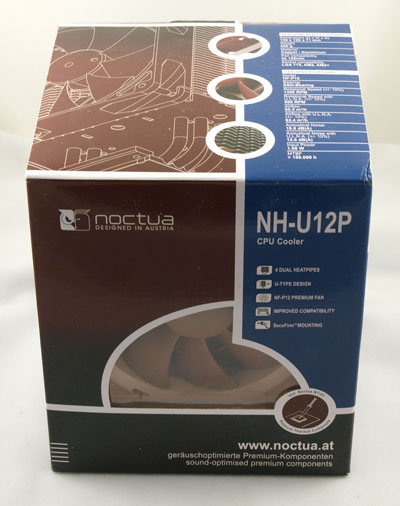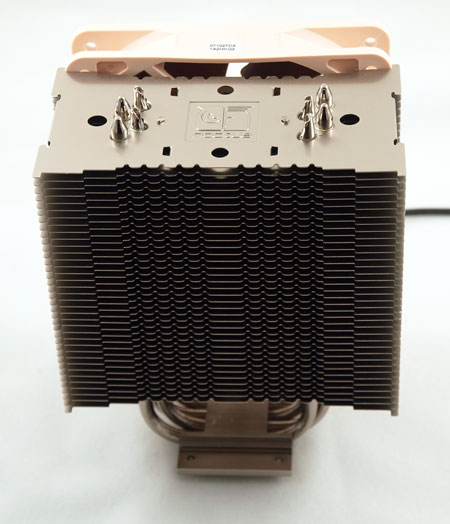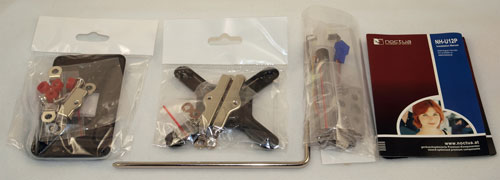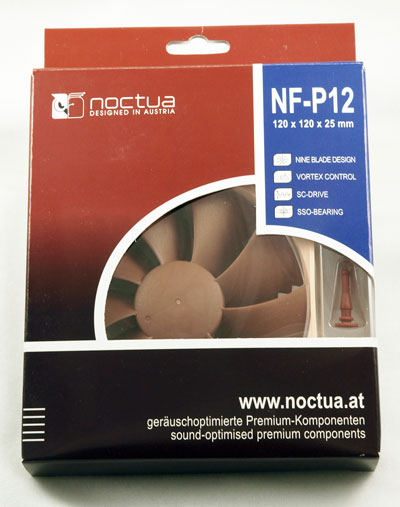Noctua NH-U12P: Top Performance AND Silence
by Wesley Fink on March 20, 2008 8:00 PM EST- Posted in
- Cases/Cooling/PSUs
The Noctua NH-U12P Cooler
Noctua has made some inroads in to the US cooler market in the past few months, but Noctua is still not a well-known brand in the US market. You won't find Noctua sold at the large US etailers like Newegg, ZipZoomFly, or mWave. You can find Noctua coolers at specialty computer enthusiast shops like Frozen CPU or Xoxide. The Noctua NH-U12P kit retails for around $69, but we have seen it selling for lower prices at a few etailers. The kit includes the Noctua NH-U12F fan, which retails for $21 by itself.

The Noctua NH-U12F continues the Noctua trademark brown and blue packaging. It seems that everything Noctua comes in packaging with variations on this corporate color scheme.

Inside the dark brown box, you will find two inner boxes with a heatpipe tower that is very reminiscent of the Thermalright Ultra-120 design and a package of mount kits and accessories. Noctua has been refining the basic design of this 120mm heatpipe tower for some time, but this heatsink is identical to the one reviewed in the NH-U12F review last year. There are fan wire channels that allow mounting of both front and rear 120mm fans on the Noctua if you choose that configuration.

You will also find an exceptionally well-protected heatsink, along with everything you need to mount the heatsink on an Intel Socket 775, or an AMD AM2/AM2+. Noctua is no longer including the AMD K8 (754/939/940) mount accessories that were part of earlier kits. The kit even includes four fan clips so there is enough hardware to mount both a front and rear fan in a push-pull configuration.

As mentioned earlier, the $21 retail S12 fan is also included and it is really the only difference from the earlier NH-U12F kit. Also included are L.N.A (Low-Noise) and U.L.N.A. (Ultra-Low Noise) adapters that fit between the fan plug and the board, which are useful for those who want to run slower speed and the lowest noise.
The included accessories abound with thoughtful little touches. Noctua includes a screwdriver that actually fits in the holes of the cooler fins to allow cooler mounting in some of the mount variations. The two included pairs of fan wire clips practically invite the buyer to try a push-pull fan setup. A clearly written installation manual with sections for both the Intel 775 and the AMD AM2/AM2+ is also in the package. Overall, the clear parts identification, abundance of mount options, and included extras make the Noctua one of the most flexible coolers we have worked with right out of the box.
Specifications
The 120mm fan is new and the only thing unique in this kit. The heatsink is the same one seen in the NH-U12F and other top Noctua kits, but it has seen further refinement since our NH-U12F review. The copper is nickel-plated in this incarnation and size and weight have minor revisions. With a design very similar to the top Thermalright coolers, it will be interesting to see if the new high-performance fan pushes this combo into the top tier of cooler performance.
| Noctua NH-U12P Heatsink | |
| Dimensions | 95(L) X 126(W) X 158H)mm (including fan) |
| Weight | 600g (excluding fan); 770g with fan |
| Material | Copper and Aluminum with soldered joints and nickel plating |
| Fan Configuration | Supports up to two 120mm fans of any thickness with open mounting posts |
| Noctua Fan | |
| Model | Noctua NF-P12 (included, but also sold separately) |
| Fan Size | 120mm x 120mm x 25mm |
| Bearing Type | SSO Bearing |
| Noise Level | 19.8dbA/16.9dbA/12.6dbA (stock/LNA/ULNA) |
| Speed | 1300/1100/900 rpm (stock/LNA/ULNA) |
| Air Flow |
92.3/78.5/63.4 cubic meters/hour (stock/LNA/ULNA)
(54.3/46.2/37.3 cubic feet/minute) |
| Fan Bearing | SSO Bearing |
| Blade Geometry | Nine-Blade Design with Vortex Control Notches |
| Input Power | 1.08W at 0.12A Input Current |
| Voltage | 12V |
| Fan Life | >150,000 hrs (vs. 50,000 hrs for ball bearing) |
| Weight | 170g (fan only) |
The vortex control notches promise high performance and the new bearings promise long fan life. Noctua has so much confidence in the new fan design that they provide a six-year warranty with the new fan. While the fan price of $21 may seem high at first, the six-year warranty promises a much longer useful life than most competing fans.










51 Comments
View All Comments
poohbear - Monday, March 24, 2008 - link
im going on previous cpus that overclocked upto 70%, currently the wolfdales that go from 2.6 to 4ghz are'nt a 50% overclock, but still bloody impressive. My opty 165 goes from 1.8-3.0ghz, which is a 66% overclock.:)Nihility - Friday, March 21, 2008 - link
I thought the F7P had terrible build quality, at least that's what I hear from the reviews on newegg.RamarC - Saturday, March 22, 2008 - link
many newegg reviewers are idiots.i've had two f7p's for the past 14 months. problems: zero; performance: fantastic. anything that can keep a pentium d 945 in the 50s under load and not sound like a f'n jet engine is fantastic in my book. and my e6600 @ 3ghz peaks in the low 40s with the fan spinning at only 800rpm.
JarredWalton - Sunday, March 23, 2008 - link
Yeah, we pretty much http://www.anandtech.com/casecoolingpsus/showdoc.a...">found the same thing in our review. No, you're not going to match the Thermalright Ultra-120 eXtreme, but then at 1/4 the cost you can't complain too much. The F7P is substantially better than retail HSF in noise levels and performance, at a cost of http://www.ewiz.com/detail.php?p=FAN-AC7PRO">$20 shipped.Syzygies - Friday, March 21, 2008 - link
I too have a Thermalright U120E push pull, using a pair of Scythe S-FLEX SFF21F fans, in an Antec P182 case decked out with other fans. I too used cable ties: One can fashion a pair of four-sided harnesses, using four cable ties each. Size them almost to fit, trimming so there's still a bit of plastic to pull on, then gingerly tighten a click at a time to snug, for a perfect fit.Anandtech has the best air cooling reviews, period, lending much-needed credibility to any comparisons with water cooling. In contrast, another site has a water cooling review that cools a 3.2 GHz Q6600 to 58 C to 62 C at full load, comparing favorably with a Zalman 9700. Those are exactly the numbers I'm getting with my U120E, and I'm getting nowhere on that forum pointing out how cooked the review looks.
For those of us trying to wring every advantage from air, we're unlikely to use an "average" case, and we're likely to consider lapping. Besided returning the U120E to the ring in push pull mode, those are my questions.
silhrt - Friday, March 21, 2008 - link
Back on the Noise Levels page, I noticed that at 6", 7 of them were at the same and at 24", 9 of them were at the same level. Rarely, if ever, are these tests with so many the same. ( not even .1 differenece ) So, this leads me to wonder if the method of testing is accurate.Is there any way to get a sensor that reads below 30? Maybe near 20?
Since its at the low end of the sensor, maybe its bottoming out?
Wesley Fink - Friday, March 21, 2008 - link
As clearly stated in the review those noise levels are the noise floor of the test system, which is equivalent to a suburban bedroon at night. Since we are running a varaiable speed low-noise power supply and fanless video card these levels represent the quietest power supply we could find that also realistically supports overclocking. The video card is fanless and zero noise.We don't test or try to measure even lower levels because that is not the way people actually run their systems. If you are interested in the noise level of a component in isolation with a power supply in another room there are other web sites that will provide you that information.
a09805 - Friday, March 21, 2008 - link
I would not blame the sensor.I guess the problem is a higher-than-desired ambient noise. There's evidently something else in the testing room that shouts in the background, and that covers the whisper of the fans. We need a more silent environment to compare noise from a fan or two. Also, we should measure noise at about 1m, that would be a typical real-world minimum distance.
For some serious thoughts and hints about silent computing visit www.silentpcreview.com.
woofersus - Friday, March 21, 2008 - link
So when are you going to slap that fan on a the big thermalright? Best fan meets best heatsink? Could be a match made in heaven even without push-pull..Wesley Fink - Friday, March 21, 2008 - link
You read our mind - or at least the hints in the Final Words :) We'll be doing it soon.